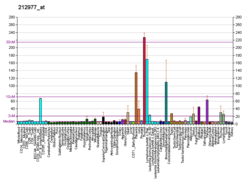CXCR7
NP_001258536.1
NP_031748.2
NP_001258536
NP_031748
Atypical chemokine receptor 3 also known as C-X-C chemokine receptor type 7 (CXCR-7) and G-protein coupled receptor 159 (GPR159) is a protein that in humans is encoded by the ACKR3 gene.
This gene encodes a member of the G protein-coupled receptor family. This protein was earlier thought to be a receptor for vasoactive intestinal peptide (VIP) and was considered to be an orphan receptor. It is now classified as a chemokine receptor able to bind the chemokines CXCL12/SDF-1 and CXCL11. The protein is also a coreceptor for human immunodeficiency viruses (HIV). Translocations involving this gene and HMGA2 on chromosome 12 have been observed in lipomas. Alternatively spliced transcript variants encoding the same protein isoform have been found for this gene. Whereas some reports claim that the receptor induces signaling following ligand binding, recent findings in zebrafish suggest that CXCR7 functions primarily by sequestering the chemokine CXCL12.
...
Wikipedia

